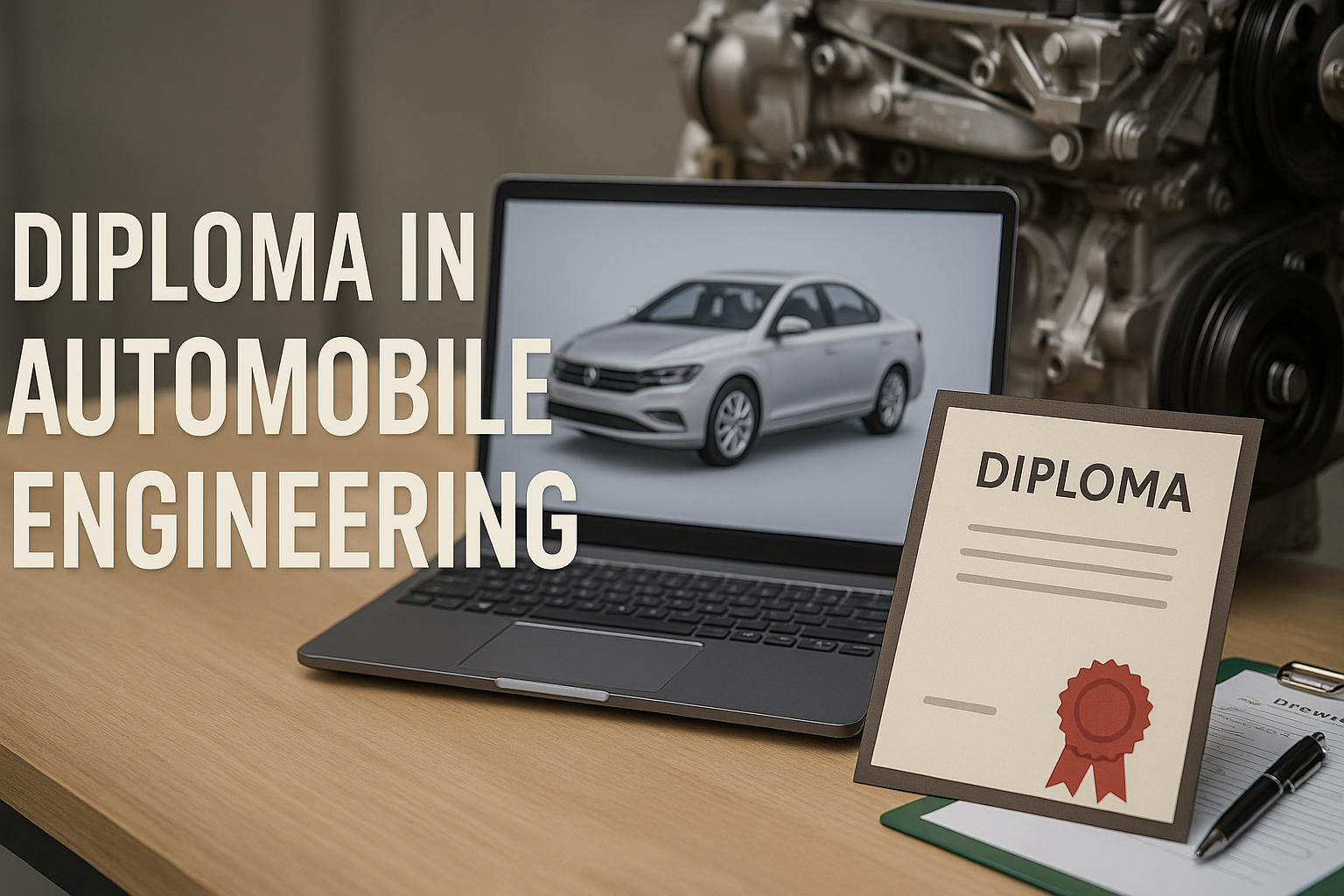For many, the fascination with automobiles starts early. It’s in the childhood toys, the posters on the wall, and the urge to understand what makes these incredible machines tick. If you’re someone who would rather be under the hood than behind a desk, a Diploma in Automobile Engineering might be the perfect key to turn your passion into a profession. This isn’t just another academic program; it’s a hands-on journey into the heart of vehicle design, manufacturing, and maintenance.
Think of this diploma as your entry point into the vast, ever-evolving world of mobility. It’s a three-year, six-semester program that molds you into a skilled technician or junior engineer, ready for the workshop floor. But not everyone’s path is the same, and the program reflects that. A popular option is “lateral entry,” which allows students who have finished Class 12 in the science stream or completed a relevant two-year ITI course to jump directly into the second year. For those already working in the industry, many institutions now offer part-time and distance learning options, a nod to the modern need for continuous upskilling.
No matter the format, every legitimate program operates under a dual-approval system. The All India Council for Technical Education (AICTE) provides the national seal of approval, ensuring the curriculum and facilities meet a certain standard. Then, the respective State Board of Technical Education (SBTE) handles the exams and awards the final diploma, tailoring things slightly to regional needs. This ensures your qualification is recognized and respected, whether you’re in Pune or Punjab.
Getting Through the Door: Admission and What It Takes
So, you’ve decided this is for you. What does it take to get in? The baseline for the standard three-year program is a Class 10 pass, usually with a minimum of 35% to 50%, with science and math as must-haves.
The selection process is typically a centralized, state-level affair. Most states run a common entrance test for their polytechnics, like the JEECUP in Uttar Pradesh, which tests your grasp of high school science and math. Your rank in this exam, combined with your category (General, OBC, SC/ST, etc.), determines your spot in the counseling queue. In some places, admission is based purely on your Class 10 marks. It’s worth noting that your domicile status—being a resident of the state—plays a huge role, as most reservation benefits and fee waiver schemes are for local students.
Once you’re through, you’ll need a stack of documents ready for verification. This includes your mark sheets, school leaving certificate, and various proofs of identity, domicile, and category. The whole cycle kicks off after the Class 10 results are out, so keeping an eye on the key dates for applications, exams, and counseling is crucial.
From Theory to the Workshop Floor: What You’ll Learn
Modern diploma programs are built on a simple but powerful idea: it’s not just about what you know, but what you can do. This is called Outcome-Based Education (OBE), and it shapes the entire curriculum. The goals are clear: to make you a competent technician, a professional with strong ethics, and someone who can adapt to new technologies like EVs.
The journey is a logical progression. The first year lays the groundwork with the fundamentals: applied mathematics, physics, chemistry, and engineering drawing. This is the shared language of all engineering disciplines.
Then, you dive into the heart of the machine. The second year is all about the core systems. You’ll get intimate with automotive engines (both petrol and diesel), understand how power gets from the engine to the wheels through powertrain and transmission systems, and explore the chassis, suspension, and brakes that form the vehicle’s skeleton. You’ll also get your first real taste of the digital side with Computer-Aided Drafting (CAD).
The final year is where it all comes together. You’ll tackle advanced topics like vehicle dynamics, diagnostics, and the all-important BS-VI emission control systems. And with the industry shifting gears, a solid introduction to Electric & Hybrid Vehicle Technology is now a staple, covering everything from motors and batteries to high-voltage safety.
But the real magic happens outside the traditional classroom. The diploma is defined by its hands-on nature. You won’t just read about an engine; you’ll tear one down and rebuild it. You won’t just learn about wheel alignment; you’ll do it. A well-equipped college will have a suite of labs that feel more like a professional garage, complete with vehicle lifts, engine cut-sections, wheel balancers, and modern diagnostic scan tools.
This practical learning culminates in two key experiences: a final-year capstone project and a mandatory industrial internship. The project is your chance to build something, to solve a problem, and to put your skills to the test. The internship, typically 4-6 weeks at a dealership, manufacturing plant, or workshop, is your first real taste of the professional world. It’s where the theory hits the road.
Beyond the Classroom: Industry Ties and Real-World Exposure
A great program doesn’t exist in a bubble. It builds strong bridges to the industry it serves. This means regular industrial visits to see how things work at an OEM plant like Tata Motors or a component supplier like Bosch. It’s one thing to see a diagram of an assembly line; it’s another to witness the controlled chaos of one in person.
The best institutions take this a step further with formal partnerships, or Memoranda of Understanding (MoUs). This can lead to incredible opportunities, like on-campus labs co-developed with brands like Mahindra or Honda, giving you access to their latest tech and training modules. These tie-ups also create a direct pipeline for internships and, ultimately, placements.
To give you an extra edge, colleges often host workshops and offer value-added certifications. Imagine graduating not just with a diploma, but also with an OEM-specific service certification or a certificate in high-voltage EV safety. These micro-credentials are a powerful signal to employers that you have specific, in-demand skills.
Life After the Diploma: Careers, Higher Studies, and Beyond
Once you have that diploma in hand, a whole ecosystem of career paths opens up. You’re qualified for a host of roles across the automotive world, from the service bay to the factory floor.
You could be a Service or Diagnostic Technician at a dealership, a Production Technician on an assembly line, a Quality Inspector ensuring every part is perfect, or a Service Advisor acting as the bridge between the customer and the workshop. The rise of electric vehicles has also created a new, high-demand role: the EV Technician.
Entry-level salaries for diploma holders typically range from ₹2.5 lakh to ₹4.5 lakh per year, with roles in the manufacturing sector often paying a bit more. Top recruiters are a mix of OEMs like Maruti Suzuki and Ashok Leyland, component giants, and the vast dealership networks of every major brand.
But a job isn’t the only path forward. For many, the diploma is a launchpad for higher education. The most common route is lateral entry into a B.E. or B.Tech program, which allows you to earn a full engineering degree in just three additional years. This is a smart move, as a degree significantly boosts long-term career growth and earning potential.
And for the entrepreneurial-minded, the practical skills gained are a perfect foundation for starting your own venture—be it a multi-brand garage, a detailing studio, or a specialized diagnostics service.
The Rules of the Road: Understanding Regulations
A modern technician does more than just turn wrenches; they ensure vehicles are safe, legal, and environmentally compliant. That’s why the curriculum includes a solid grounding in the key regulations governing the Indian auto industry.
You’ll learn about the Central Motor Vehicles Rules (CMVR), the foundational legal text for all vehicles in India. You’ll also be introduced to the Automotive Industry Standards (AIS), which are the detailed technical specs for everything from crash safety to EV batteries.
A huge focus is on the Bharat Stage VI (BS-VI) emission norms. The jump from BS-IV to BS-VI was a massive technological leap, introducing complex after-treatment systems like Diesel Particulate Filters (DPF) and Selective Catalytic Reduction (SCR). Understanding how to diagnose and service these systems is a non-negotiable skill for today’s technician.
Making It Happen: Fees, Financial Aid, and Finding the Right Fit
The cost of a diploma can vary wildly. Government polytechnics are heavily subsidized and incredibly affordable, with the entire three-year program sometimes costing as little as ₹6,000 to ₹18,000. Private institutions, on the other hand, can range from ₹30,000 to over ₹3,00,000 for the full course.
Thankfully, a wide net of financial aid is available. Government scholarships for students from SC, ST, OBC, and EWS categories are common. The AICTE also runs specific schemes for girls and specially-abled students. One of the most significant programs is the Tuition Fee Waiver Scheme (TFWS), which offers a full tuition waiver to meritorious students from lower-income families.
So, how do you judge the quality of a program? Look for two key things: AICTE approval and NBA accreditation. Think of AICTE approval as the mandatory license to operate—it means the college meets the minimum standards for infrastructure and faculty. NBA accreditation, however, is the seal of excellence. It’s a voluntary, rigorous process that evaluates a program based on its outcomes—essentially, how well it achieves its goal of producing skilled, employable graduates. An NBA-accredited program gives you a definite edge in the job market.
Life on Campus
Your time at polytechnic is about more than just classes and labs. It’s about growth. Student support systems like faculty mentoring and career counseling are there to guide you. But the real excitement often lies in co-curricular activities.
The SAE (Society of Automotive Engineers) Collegiate Club is a cornerstone of campus life for any aspiring auto engineer. This is where you can join teams to design and build vehicles from scratch for national competitions like BAJA (an all-terrain vehicle challenge). It’s an intense, hands-on experience that teaches you more about teamwork, project management, and real-world engineering than any textbook ever could.
Your Questions, Answered
- What about admission cut-offs? Cut-offs are the opening and closing ranks from the previous year’s entrance exams. They give you a good idea of how competitive a particular college is. For example, a government polytechnic might have a closing rank in the low thousands, while a private one might admit students with ranks closer to 100,000.
- Do I need my own tools? Yes, you’ll likely be expected to have a basic personal toolkit (spanners, screwdrivers, etc.) and your own Personal Protective Equipment (PPE), especially a pair of steel-toed safety shoes.
- How do I apply? The process is almost entirely online through your state’s centralized admission portal (like
jeecup.nic.infor UP). You’ll register, fill out the form, upload documents, pay a fee, and then participate in the online counseling for seat allotment.
The Diploma in Automobile Engineering is a direct, practical, and rewarding path into an industry that is quite literally driving the future. It’s a qualification that respects the craft of working with your hands while equipping you with the knowledge to tackle the complex technologies of tomorrow.




Pingback: Polytechnic Admission in Delhi 2025–2026: